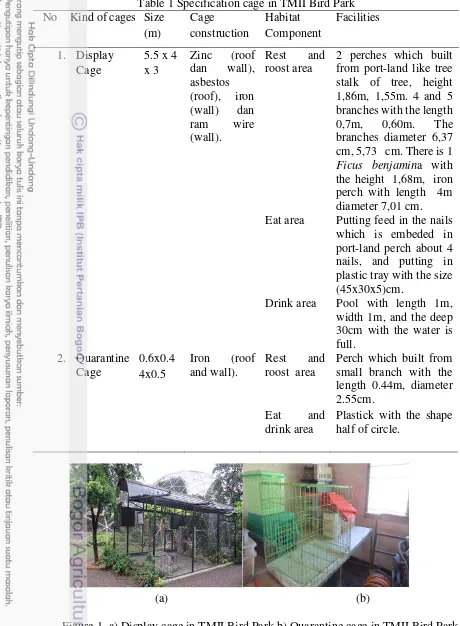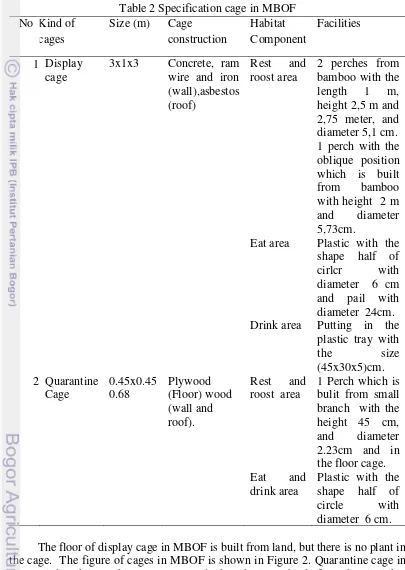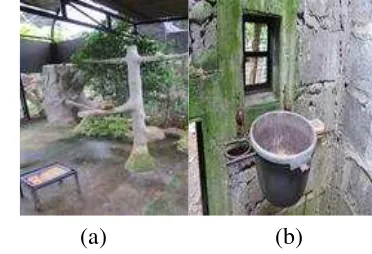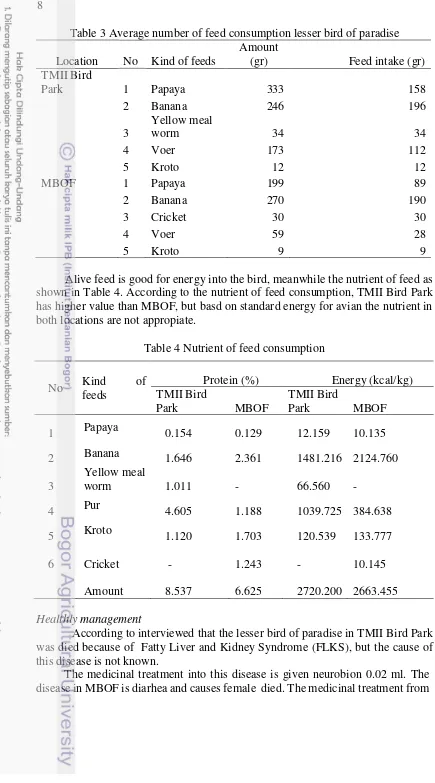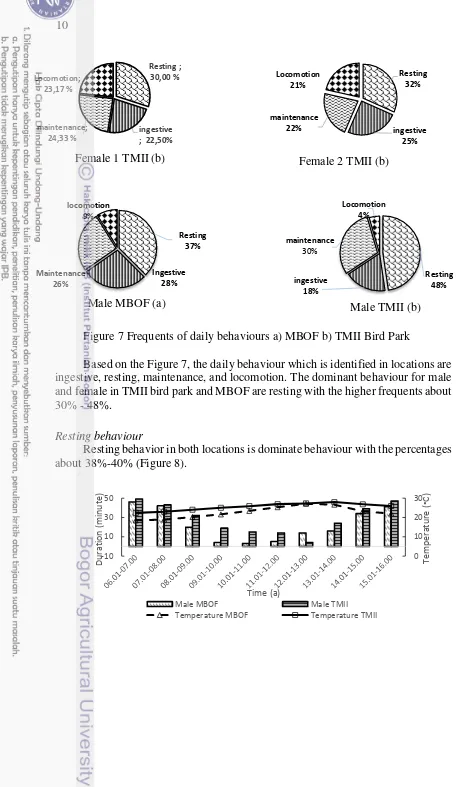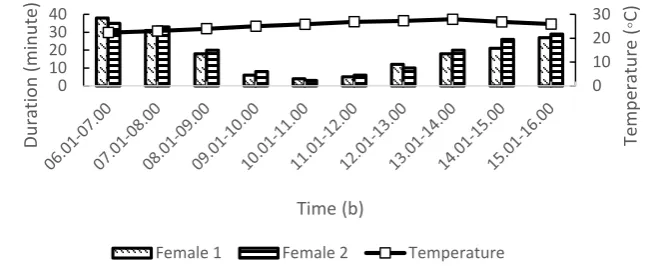THE CAPTIVE BREEDING OF LESSER BIRD OF PARADISE (
Paradisaea
minor
Shaw, 1809) IN TAMAN MINI INDONESIA INDAH BIRD PARK AND
MEGA BIRD AND ORCHID FARM
KEN DARA CITA
DEPARTMENT OF FOREST RESOURCES CONSERVATION AND ECOTOURISM FACULTY OF FORESTRY
BOGOR AGRICULTURAL UNIVERSITY BOGOR
DECLARATION OF BACHELOR (HONS) THESIS,
INFORMATION SOURCE AND COPYRIGHT
I hereby that this bachelor (Hons) thesis with the title is The Captive Breeding of Lesser Bird of Paradise in TMII Bird Park and MBOF is true of my work with the direction by supervisor and it has not been submitted everywhere. The infomation have been mentioned in the text and listed in the List of Literatures at the end of this bachelor (Hons) thesis.
I hereby that the copyright of my research to the Bogor Agricultural University.
ABSTRACT
KEN DARA CITA. The Captive Breeding of Lesser Bird of Paradise (Paradisaea minor Shaw, 1809) at Taman Mini Indonesia Indah Bird Park and Mega Bird and Orchid Farm. Supervised by JARWADI B HERNOWO and BURHANUDDIN MASY’UD.
Ex situ conservation is a means to save wildlife animal include lesser bird of paradise. Taman Mini Indonesia Indah (TMII) Bird Park and Mega Bird And Orchid Farm (MBOF) were two institutions that support ex-situ conservation program with different purposes. TMII Bird Park has non-commercial purpose breeding, while MBOF has commercial purpose in captivity breeding. The objectives of this research was to describe the management of captive breeding of lesser bird of paradise with the influencing factor for captive breedig success and the daily behavior of lesser bird of paradise in the cage. This research was conducted from March until April 2015. Focal animal sampling and one zero sampling method were employed to observe daily behaviour. The results showed that there were not differences in management between the two locations, and did not success for breeding. The behaviors had been identified were: resting, ingestive, locomotion, and maintenance behavior. The disturbances caused by visitors and other animals.
Keywords: daily behaviors, lesser bird of paradise, management of captivity
ABSTRAK
KEN DARA CITA. Penangkaran Cendrawasih Kuning Kecil (Paradisaea minor Shaw,1809) di Taman Burung, Taman Mini Indonesia Indah dan Mega Bird and Orchid Farm. Dibimbing oleh JARWADI B HERNOWO dan BURHANUDDIN MASY’UD.
Konservasi eksitu adalah suatu cara untuk melestarikan satwaliar termasuk salah satunya cendrawasih kuning kecil. Taman Burung, Taman Mini Indonesia Indah (TMII) dan Mega Bird and Orchid Farm (MBOF) adalah dua institusi yang melakukan penangkaran dengan tujuan berbeda yakni lembaga konservasi yang bersifat non komersil dan yang bersifat komersil. Tujuan penelitian ini adalah untuk mendeskripsikan teknik pengelolaan penangkaran cendrawasih kuning kecil, serta faktor yang mempengaruhi keberhasilan penangkaran dan mengkaji perilaku harian cendrawasih kuning kecil di dalam kandang. Penelitian dikumpulkan dengan cara wawancara, pengukuran, dan observasi dilakukan pada Maret-April 2015. Hasil penelitian diketahui bahwa teknik pengelolaan penangkaran dikedua lokasi tidak berbeda, dan belum berhasil mengembangbiakan cendrawasih kuning kecil yang ditangkarkan. Perilaku yang teridentifikasi dikedua lokasi antara lain perilaku istirahat, ingestif, dan merawat tubuh dengan perilaku yang mendominasi adalah perilaku istirahat.
Bachelor (Hons) Thesis
Submitted to fullfilment of the requirement for the degree of Bachelor of Science (Hons) in Forestry in Department of Forest Resources Conservation and Ecotourism
Faculty of Forestry, Bogor Agricultural University
THE CAPTIVE BREEDING OF LESSER BIRD OF PARADISE (
Paradisaea
minor
Shaw, 1809) IN TAMAN MINI INDONESIA INDAH BIRD PARK AND
MEGA BIRD AND ORCHID FARM
KEN DARA CITA
DEPARTMENT OF FOREST RESOURCES CONSERVATION AND ECOTOURISM FACULTY OF FORESTRY
BOGOR AGRICULTURAL UNIVERSITY BOGOR
ACKNOWLEDGEMENTS
All praises and thanks to Almighty Allah SWT, Who is entire source of knowledge and wisdom endowed to mankind also for His blessing that the author is able to finish the bachelor (Hons) thesis entitled The Captive Breeding of Lesser Bird of Paradise in Taman Mini Indonesia Indah (TMII) Bird Park and Mega Bird and Orchid Farm (MBOF).
The author would like to express her appreciation to Dr Ir Jarwadi B Hernowo, MScF and Dr Ir Burhanuddin Masy’ud, MS for their advices during her research. The author would like to express her appreciation to her parents Prapto Waluyo, M.Hum, and Ai Rohayati, S.Pd, her brother Zen Wisa Sartre, and her aunts for their support. Her gratitude is to TMII Bird Park staff specially for drh. M Piter Kombo, Mr Kalim, Mr Amar, Mr Kono, Mrs Yuni and to MBOF staff specially for Drs Megananda Daryono MBA, Mr Supriyanto Akdiatmodjo, Mr Gareng, Mr Hari, Mr Imam, Mr Huda for helping her to complete the research. She also take this opportunity to say thanks to all of her friends especially for Galuh, Priscil, Eterna, Rizka, Panji, KSHE 48 Family and Way Kambas PKLP Team.
Hope this bachelor (Hons) thesis will be usefull for everyone.
CONTENT
LIST OF TABLES vii
LIST OF FIGURES vii
INTRODUCTION 1
Background 1
The Objectives 1
Benefit of The Research 1
METHODS 2
Time and Place 2
Methods 2
Data Analysis 2
RESULT AND DISCUSSION 3
Result 3
Discussion 13
CONCLUSION AND SUGGESTION 17
Conclusion 17
Suggestion 17
LIST OF TABLES
1 Specification cage in TMII Bird Park 4
2 Specification cage in MBOF 5
3 Average number of feed consumption lesser bird of paradise. 8
4 Nutrient of feed consumption 8
LIST OF FIGURES
1 Display cage and quarantine cage in TMII Bird Park 4
2 Display cage and quarantine cage in MBOF 6
3 Temperature and humidity in TMII Bird Park and MBOF 6
4 Lesser bird of paradise a) male b) female 7
5 Giving feed a) TMII Bird Park b) MBOF 7
6 Visitors in TMII Bird Park 9
7 Frequents of daily behaviours a) MBOF b) TMII Bird Park 10
8 Resting behaviour a) male b) female 11
9 Ingestive behaviour a) male b) female 11
10 Locomotion behaviour a) male b) female 12
INTRODUCTION
Background
Lesser bird of paradise (Paradisaea minor Shaw, 1809) is one of endemic bird species in Papua. The distribution of this bird is Papua Island, Salawati Island, Numfor Island, Num Island, Meos Island, Biak Island, Yapen Island, Misool Island, and Waigeo Island. Based on Sukmantoro (2007), Lesser bird of paradise is least concern in IUCN (International Union for Conservation of Nature and Natural Resources), listed in Appendix II in CITES (Convention on International Trade in Endangered Species of Wild Fauna and Flora) which this bird will be extinct if exploitation and illegal hunting continues without rules. The Indonesian government listed this bird into one of the endangered bird species, and protected by UU No 5 1990 and PP No 7 1999.
Lesser Bird of Paradise population was decrease to year and year. The decreasing of population are because of Illegal hunting, and habitat destruction which increased the quality and quantity of habitat especially for feed, shelter, and cover. According to Nature Conservation Agency Papua in March 2012 found 2-3 individuals of lesser bird of paradise for one kilometers. The threatened of lesser bird of paradise in natural habitat needs ex situ conservation especially captive breeding to increase the population of lesser bird of paradise in natural habitat.
Taman Mini Indonesia Indah (TMII) Bird Park and Mega Bird and Orchid Farm (MBOF) are institutions in captive breeding of lesser bird of paradise with differences aims. TMII Bird Park is conservation institution. It is not for commercial but MBOF is captive breeding for commercial. Both two institutions are not success in captive breeding, meanwhile the population of lesser bird of paradise in natural habitat is decrease more and more. The captive breeding success is influenced by knowledge about captive breeding technique, healthy management, feed management, and daily activity to fulfiil animal welfare aspect.
The data and information about ex situ conservation of lesser bird of paradise is limited. The data and information are important as a basic data, therefore this research is important to support the preservation of lesser bird of paradise.
The Objectives
The objectives of this research are to describe the management of captive breeding of lesser bird paradise in TMII Bird Park and MBOF with the influencing factor for captive breeding success, and to describe the daily behavior of lesser bird of paradise in the cage.
Benefit of The Research
2
METHODS
Time and Place
This research was conducted from March until April 2015. The locations of this research are in TMII Bird Park and MBOF.
Tools and Equipments
The tools and equipments used in this study included Tallysheet, Stationery, Stopwatch, Dry Wet Termometer, Gauge, Webcam M-Tech, software webcam 7, lesser bird of paradise, habitat, feed, and management of captivity.
Methods
The methods to collect the data are measuring the feed and size of cage, observation, interview and literature study. To know the daily behavior of lesser bird of paradise used Focal animal sampling and One Zero Sampling. Every behaviour was writen about the frequent and duration during 10 hours, it was begun at 06.00am until 4.00 pm.
Data Analysis
Captive breeding
The supporting data obtained from the interview and captive breeding techniques were analyzed descriptively include history of captive breeding, population, cage, feed, healthy management, and reproduction technique. The feed data analysis was also counted quantitatively.
Consumption amount
Notes:
JK = Consumption amount
B = feed weight before feeding activity b = residual feed weight
Feed consumption
Protein consumption (%) :
JK = B-b
Σ one of feed consumption
3 Calory (Kcal) :
Daily behaviour
The daily behaviour is described descriptively, there are resting, ingestive, locomotion, and maintenance. The frequent of daily behaviours is based on Martin and Bateson (1988) :
Keterangan:
A : One of behaviour frequent B : Completely behaviours frequent Breeding success
The data on the parameters of breeding success was also analyzed by criterias (Purwaningsih 2012) they are :
1. Successful : If female lays egg, hatching its egg, and the juvenil can live about 3 months
2. Success enough : If female lays egg, hatching its egg, but the juvenil cannot live until 3 months
3. Less success : If female lays egg, but its egg does not hatch 4. Not success : There is not female lays egg
RESULT AND DISCUSSION
Result
Captive breeding technique Cage aspect
There are two kind of cages for lesser bird of paradise in TMII Bird Park display cage and quarantine cage. Kind of cages, size, construction, habitat component, and facilities as shown in Table 1. The cage in captive breeding must be like in natural habitat, and the bird can behave normally like in natural habitat include breeding. Display cage in TMII Bird Park is used to maintain and breeding, meanwhile quarantine cage is used when the bird is sick. In the cage is present a male, 2 females, and a male from different species that is Paradisaea rubra. The floor of cage is built from port-land with hole to water pipeline. Display cage and quarantine cage is shown in Figure 1. The keeper cleans the cage every morning.
% Σ one of feed consumption
4
Table 1 Specification cage in TMII Bird Park No Kind of cages Size branches with the length 0,7m, 0,60m. The branches diameter 6,37 cm, 5,73 cm. There is 1 Ficus benjamina with the height 1,68m, iron perch with length 4m diameter 7,01 cm. Eat area Putting feed in the nails
which is embeded in port-land perch about 4 nails, and putting in plastic tray with the size (45x30x5)cm. length 0.44m, diameter 2.55cm.
Eat and drink area
Plastick with the shape half of circle.
5 The kind of cages in MBOF are display cage and quaratine cage. In MBOF Display cage is only for maintan, that is not for breeding because there is not female in the cage. Specification of cages in MBOF is shown in Table 2 .
Table 2 Specification cage in MBOF
The floor of display cage in MBOF is built from land, but there is no plant in the cage. The figure of cages in MBOF is shown in Figure 2. Quarantine cage in TMII Bird Park is used in wet season and when the lesser bird of paradise is sick
6
The manager in TMII Bird Park said that the lesser bird of paradise was very sensitive and easy to get sick, meanwhile in MBOF quarantine cage is used when the bird is sick. Cage in both institutions were cleaned every 7 am during 15minutes.
The temperature in the TMII Bird Park display cage is 22.37⁰C - 27.93⁰C and humidity is 73,5%-95%, meanwhile the temperature in the MBOF display cage is 18.50 ⁰C -27.10⁰C and humidity 74% - 94% (Figure 3).
Figure 3 a) Display cage in MBOF b) Quarantine cage in MBOF
Figure 2 a) Temperature in TMII and MBOF b) Humidity in TMII and MBOF
7 The origin of lesser bird of paradise
Lesser bird of paradise in TMII Bird Park is given from someone (anonim) in 2014 as many as 2 female and a male but lesser bird of paradise in MBOF comes from natual habitat with permission from ministry of forestry SK.22 /IV-SET/2011 for a male and a female. The birds’ condition of both locations are healthy. The morpholgy showed that the bird in both location was adult. The figure of lesser bird of paradise is shown in Figure 4.
Feed and water management
The main feed in TMI Bird Park are voer, papaya, banana, and in TMII Bird Park the main feed are “voer”, papaya, banana, and yellow meal worm but in MBOF the main feed are “voer”, papaya, banana, and cricket. “Kroto” is addition food in both locations. The management gives “kroto” for twice a week. Feed and drink in adolescence are given every morning everyday, with a frequency of one time.
Feed source for lesser bird of paradise in TMII Bird Park is from supplyer which is cooperating with the manager, meanwhile in MBOF the feed source is from the marker near the location. In TMII Bird Park the feed is given in the pool-land which is like in natural habitat, but in MBOF the feed is given by plastick (Figure 5).
Based on the kind of feeds in both locations, it can get the number of consumption (Table 3). According to the table showed that lesser bird of paradise likes yellow meal worm, cricket, and “kroto” the more and lesser bird of paradise is like alive feed. Feed is one of main aspect to support success of captive breeding.
(a) (b)
(a) (b)
8
Table 3 Average number of feed consumption lesser bird of paradise Location No Kind of feeds
Alive feed is good for energy into the bird, meanwhile the nutrient of feed as shown in Table 4. According to the nutrient of feed consumption, TMII Bird Park has higher value than MBOF, but basd on standard energy for avian the nutrient in both locations are not appropiate.
Table 4 Nutrient of feed consumption
Healthly management
According to interviewed that the lesser bird of paradise in TMII Bird Park was died because of Fatty Liver and Kidney Syndrome (FLKS), but the cause of this disease is not known.
The medicinal treatment into this disease is given neurobion 0.02 ml. The disease in MBOF is diarhea and causes female died. The medicinal treatment from
No Kind of
feeds
9
Figure 6 Visitors in TMII Bird Park
MBOF is given “spektra” about 3 drops in the water of lesser bird of paradise. To prevent the disease. They have done medical check up every day, give vitamin B6, B12, honey, and antiseptic to the cage.
Reproduction
In 1996 TMII Bird Park had successed in captive breeding, in the first dome with the size height 30 meters, diameters 50 meters (Taman Burung TMII 1997). In MBOF there is not success in breeding. Nowdays TMII Bird Park and MBOF are not success in captive breeding. The generally, sucess criteria of captive breeding of bird if female has lays egg. According to the criteria in both locations are not success in captive breeding, that are because of no female lays egg. Influencing factor for the captive breeding success
There are two factors which are influence to the captive breeding success. The first is internal factor that is age structure. In adult age lesser bird of paradise is easier to breeding. Lesser bird of paradise in TMII Bird Park is one year old but in MBOF lesser bird of paradise is five years old. The second is external factor there are feed consumption and nutrient of the feed, size of cage, and distrubance into the bird. Disturbance will have a negative effect to lesser bird of paradise. The disturbance in TMII Bird Park is higher than MBOF, they are : visitor and another species (Passer montanus and Paradisaea rubra ). Number of visitors in TMII Bird Park was ± 7045 people per month. Many visitors can be stressed for the bird. The figure of visitors are shown in Figure 6. Other problems that happened was competitors in the cage, Paradisaea rubra which was more active than lesser bird of paradise and Passer montanus which ate the feed of lesser bird of paradise.
Daily behaviour
10
Figure 7 Frequents of daily behaviours a) MBOF b) TMII Bird Park
Based on the Figure 7, the daily behaviour which is identified in locations are ingestive, resting, maintenance, and locomotion. The dominant behaviour for male and female in TMII bird park and MBOF are resting with the higher frequents about 30% - 48%.
Resting behaviour
11
Resting behaviour for male in TMII Bird Park and MBOF was done in the perch, but for female was done in the branch. Resting behaviour was done with the bow head.
Ingestive behaviour
The duration of ingestive behaviour is increase when the keeper gives the feed and it will decrease in the afternoon (Figure 9). During the observation that is not drinking activity.
12
Locomotion behaviour will increase in the morning the sunshine (Figure 10).
Figure 10 Locomotion behaviour a) male b) female
Based on the observation, the duration of locomotion behaviour of lesser bird of paradise in captive breeding is different with the natural habitat. Locomotion behaviour in TMII Bird Park is higher than in MBOF.
Maintenance behaviour
Preening is the dominate activity in maintenance behaviour. Maintenance behavior is to keep the plumage of lesser bird of paradise to be cleaned, and looked healthy. The higher duration for maintenance when the temperature is increase (Figure 11), and the male is more dominant than female.
13
Discussion
Captive breeding technique Cage aspect
Cage aspect is the main aspect to support the captive breeding success. The cage in captive breeding should be like in natural habitat, therefore the bird can behave like in natural habitat. Based on Mas’ud 2002 cage construction, size of cage, and environment in the cage are must be like in natural habitat. The condition is as like as natural habitat can be done with planting the trees for cover, shelter, available for feed and water, and free from disturbance (Setio and Takandjanji 2007) .
Components in the cage that support successing captive breeding are planting the tree (Ficus benjamina), pond, perch, and small branch, leaves, but that is not nest box in the cage. According to Latupapua (2006) in natural habitat Ficus bejamina is used for breeding, and resting. In natural habitat the nest of lesser bird of paradise which was constructed of twigs and lined with black wire-like fibres or rootlets nd outside was patrially covered with dead leaves (Gilliard 1969). Display cage in MBOF only used for maintenance. In the front of cages are opened in both locations. It is done to keeper easier in checking the healthy of bird and entering sunshine. Mas'ud (2002) explain that an ideal reproduction cage has good ventilation, uses wire ram roof and asbestos on the other side as a shelter, and applies soil floor so that the droppings are easily biodegradable. The cage should be maximally exposed to morning sunlight and free from floods and the disturbance of the predators.
The size of the cages in TMII Bird Park and MBOF were appropriate but both were not optimal when they were adapted to the natural behaviour of lesser bird of paradise in natural habitat. Lesser bird of paradise has homerange about 2 km (Maturbongs et al 1994 in Buntu 2002).This type of bird is a kind of birds that doing its activities on the top of trees both for resting, mating and nesting (Latupapua 2006).
Based on the cage, to support the success breeding for lesser bird of paradise make the wider size of cage, the minimum size for breeding cage paradise is based
14
on first dome in TMII Bird Park so that the bird can behave normally including breeding the minimum size for breeding cage is 30 meters for the high and 50 meters for the diameter.
The temperature in the TMII Bird Park display cage is 22.37⁰C - 27.93⁰C and humidity is 73,5%-95%, meanwhile the temperature in the MBOF display cage is 18.50 ⁰C -27.10⁰C and humidity 74% - 94%. In natural habitat the temperature is 24,5-27⁰C for 0-500 mdpl and 20-21.5⁰C for 1000-1500 mdpl, so in TMII Bird
Park that is appropiate with natural habitat. Humidity in natural habitat is 70%-90%
with the result that in both location is appropiate with natural habitat Handoko (1995). Humidity will influence in breeding.
Feed management
A good quality of feed give a good effect for healthy and welfare animals. Based on Alhamid et al (1993) in Buntu (2002) in natural habitat the feeds of lesser bird of paradise are beries, reptile, insect, and worm. Gilliard (1969) said that from the stomatch analyses indicate that vine fruits, often large and nut-like or small with hard yellow or black pits and a few insect are the usual fare. The feed of bird of paradise is divided into 3 kinds there are fig (F), drupe (D) capsule (C) (Beehler 1983).
Kind of trees which are source to find the feed are Areca catechu and Eugenia spp (Latupapua 2006). Alhamid et al (1993) in Buntu (2002) said that the habitat to find the feed arecFicus sp, Celtys sp, Myristica sp, Endospernum medullosum dan Disoxylon acuntangwlum.
The feed in TMII Bird Park and MBOF are not appropiate with natural habitat, and the feed is given by the keeper and depends on the keeper, then rhe amount of feed change everyday. Feed changeable without dose as needed birds can affect the healthy of the bird like obesity if the feed is much more, and malnutrion if the feed is very a few. Obesity, and malnutrition affects to metabolism of the birds.
According to Table 2 showed that lesser bird of paradise likes yellow meal worm, cricket, and kroto the more. Based on Buntu 2002 in Biak, lesser bird of paradise is like alive feed. Alive feed contains with protein and gives higher energy for th bird body and metabolism. Energy is benefical to daily activites of lesser bird of paradise (Kateran 2010). Protein is needed by animals to increase productivity and improve egg hatchability of eggs (Kateran 2010). Sudarwo and Siriwa (1999) describe that the number of energy in poultry of 2900-3200 kcal/kg and protein requirement of 10-30 %, so it can be said that both institutions are not appropiate from standard energy.
Health and care management
15 Reproduction
In natural habitat the period breeding season was on July and August in the latter part of the dry season. The lesser bird of paradise is polygamus in breeding system and has complex system in breeding (Irestedt et al 2009), the system si lek system. Lek structure was similar to previous findings with most courts clustered in close proximity and the courts of few individuals more dispersed (Beehler 1983). In the lek area there are several males which are comptetion to interest the female. The arena display in the top of single tree with males dancing close together (Gilliard 1969). In addition to the regular attendant males, an additional number of males, most in subadult plumage, visited the lek but did not own perches. These birds spent most of the time out of the lek, calling from perches dispersed through the surrounding forest. They would visit the lek when courtship activities reached a peak. These birds observed the courtship activities but never actually displayed, When a female entered the lek to mate, the perch holding males became visibly agitated, called loudly, erected their yellow pectoral plumes, and often hopped about from limb to limb, flapping their wings and shivering their plumes. After this brief flurry of motion and calling, the males assumed their perches and quietly displayed their erected pectoral plumes while the female moved about the lek, often visiting the limbs of several different males in display (Beehler 1983).
Data on male-female interactions at the lek provide some insight into the nature of sexual selection in this type of breeding system. Bradbury (1981) in Behleer (1983) postulated that female choice of mates is a driving force in the evolution of the lek system. In contrast Le- Croy (1981)in Behleer (1983) asserted that male-male hierarchical interactions are of primary importance in lek mating, at least for birds of paradise. Male often performs with dancing in the single top of tree and call female. A typical call was we wee wa waa wa (Gilliard 1969) and sexual calling was "yaack" and "nyaack" (Behleer 2001). Kind of trees that used to breeding and nesting are Myristica fatua, Canarium vulgare, Eugenia rumphii, Diospyros lolin (Latupapua 2006).
Influencing factor for the captive breeding success
Internal factor that include the success in captive breeding is the age of sexual maturity is not only seen in the adult of body. Rand and Gilliard (1967) said that adulty male has yellow flank pules and elongated tail wies. Viewed in sex ratio in both locations are not appropiate with bioecology the bird. In natural habitat lesser bird of paradise can be copulate with 7 females in one breeding season (Behleer 1981).
16
Daily behaviour
Based on calculations, resting in TMII Bird Park and MBOF has a higher percentage than other behaviors. This is because of lesser bird of paradise has to adapt to the environment in the cage and the movement activity is limited (Alcock 2001).
In natural habitat lesser bird of paradise will be doing a lot of movement, for example serching for food, drink, and avoid predators. Lesser bird of paradise make a group for playing in the perch or branch in the afternoon (Beehler et al 2001) and very actively. The kind of trees that is used to play by lesser bird of paradise are Ficus benjamina, Hapololobus sp, Palaquium sp dan Pandanus sp. (Maturbongs et al 1994 dalam Buntu 2002).
Resting behaviour
The results showed that resting behavior is done in the early morning and late afternoon. Males in both locations have higher frequency for resting than females, it is consistent with the statement by Rostika (1999) in Shabrina (2015) that the activity of roast is more often done by males, this is because males are more active than females, and to maintain and to balance the body, males require longer rest periods.
In natural habitat lesser bird of paradise are often seen perched and rest at the top of the tree with a height of 50-60 m, and can also be found in the low scrub but it is hard to find because of its will look for a safe place far from disturbance. Birds of paradise usually resting on a tree such as : Areca catechu, Diospyros lolin, Pometia pinnata, Ficus benjamina, Canarium vulgare (Latupapua 2006)
Ingestive behaviour
Ingestive behavior begins with fly or jump to the source of the feed, and the pecking feed is repeatedly. According to Gill (2007) in Kurniawan (2014), the bird has a high metabolic rate, so it has a lot of feed as a source of energy to do its activities. Males in MBOF have higher percentage than in the TMII Bird Park, it caused by males in MBOF did not have competitors in getting the feed.
During the observation rarely seen drinking activities in both locations. It caused by the feed are given in TMII Bird Park and MBOF are fresh fruits and contains a lot of water.
Locomotion behaviour
Based on calculation of percentage frequency of locomotion behavior in TMII Bird Park is higher than in MBOF, it caused by in TMII Bird Park is more disturbances than MBOF.
Lesser bird of paradise in both locations are very sensitive to disturbances around the cage. When there is a disturbance, the bird looks stressed , fly and sometimes it crashing into the wire ram. Forshaw and Cooper (1989) said when the birds get distrubances, the bird will fly high.
Maintenance behaviour
17 the body and gives warm temperature to the body of bird (Takandjanji and Mite 2008). The higher duration for maintenance when the temperature is increase, and the male is more dominant than female. Preening is done when the bird perching in the perches and scratch the body. Take a bath is to keep the plumage and cooling the body when the temperature is higher (Prijono and Handini 1998).
CONCLUSION AND SUGGESTION
Conclusion
The management of captive breeding in both locations are not different significant. Captive breeding technique in the both of locations consist of cage, feed, healthy care, and breeding which are not enough optimal because they are different with lesser bird paradise bioecology in the natural habitat. The management which is not suitable in TMII Bird Park because the cage has small size, is consisted by 2 different species.
The daily behaviour lesser bird of paradise in TMII Bird park and MBOF are influenced by temperature and the environment around the cage. The dominate behaviour is resting with the percentage 30% until 48%. There is not breeding behaviour, so in both locations are not success in captive breeding.
Suggestion
1. The manager and keeper should be had knowledge about bioecology of lesser bird of paradise.
2. The manager in both locations have to give an appropiate feed.
3. To repair size of cage become more bigger size minimum size like the aviary in TMII (50 meters for diameter, and 30 meters for the height), plant trees as like as natural habitat.
4. To intensive daily monitoring every day.
LIST OF LITERATURES
Alcock J.2001. Animal Behavior: An Evaolutionary Approach. 7th ed. Sunderland Beehler B. 1981. Plumage and Courtship Display, Popular Account Paradiseidae. London (GB): Biosis and The Zoologycal Society of London.
Beehler B. 1983. Lek behaviour of the lesser brd of paradise. Auk. 100.
Beehler B, Thane K P, Zimmerman DA. 2001. Burung-Burung Di Kawasan Papua. Papua, Papua Nugini Dan Pulau-Pulau Satelitnya. Birdlife International Indonesia Programme. Jakarta(ID) : PT Ghalia Indonesia. Buntu E. 2002. Tingkat kesukaan burung cenderawasih (Paradisaea sp) terhadap
beberapa jenis pakan di Taman Burung dan Taman Anggrek Biak [skripsi]. Manokwari(ID); Univeritas Negeri Papua.
18
Gilliard E.T. 1969. Birds of Paradise and Bower Birds. London(GB) : Weidenfeld and Nicolson.
Handoko. 1995. Klimatologi Dasar: Landasan Pemahaman Fisika Atmosfer dan Unsur-unsur Iklim. Bogor (ID): Pustaka Jaya.
Hidayati. 2014. Kajian kasus degenerasi lemak pada burung cendrawasih (Paradisaea minor) [skripsi]. Bogor : Fakultas Kedokteran Hewan, Institut Pertanian Bogor.
Irestredt M, Jonsson KA, Fjeldsa J, Christidis L, Ericson PGP. 2009. An unexpectedly long history of sexual selection in boed of paradise. BMC Evol Bio. 9(235):1-11.
Kateran PP. 2010. Requirement of nutrient of oloutry livestock in Indonesia. Wartazoa. 20(4): 172-180.
Kurniawan H. 2014. Teknik Penangkaran dan Perilaku Harian Jalak Putih di Mega Bird and Orchid Farm Bogor, Jawa Barat [skripsi]: Fakultas Kehutanan, Institut Pertanian Bogor.
Latupapua L. 2006. Kelimpahan dan sebaran burung cendrawasih (Paradisaea apoda) di Pulau Aru Kabupaten Kepulauan Aru Propinsi Maluku. Jurnal Agroforestri. 1(3) : 40-49.
Martin P, Bateson P. 1988. Measuring Behaviour An Introduction Guide 2nd ed. Cambridge (UK) : Cambridge Univ Pr.
Mas’ud B. 2002. Kiat Mengatasi Permasalahan Praktis Menangkarkan Cucak Rawa.
Jakarta (ID): AgroMedia Pustaka.
Prijono SN, Handini S. 1998. Memelihara, Menangkar, dan Melatih Nuri. Jakarta (ID): Penebar Swadaya.
Purwaningsih DA. 2012. Faktor-faktor penentu keberhasilan penangkaran merak hijau jawa (Pavo muticus) di Taman Margasatwa Ragunan dan Taman Burung Taman Mini Indonesia Indah Jakarta [skripsi]. Bogor (ID): Institut Pertanian Bogor.
Rand AL, ET Gilliard. 1967. Handbook of New Guinea Birds. London(GB):The Trinity Press.
Setio P, Takandjandji M. 2007. Konservasi ek-situ burung endemik langka melalui penangkaran. Prosiding Ekspose Hasil-hasil Penelitian; Padang, 20 September 2006. Bogor: Pusat Penelitian dan Pengembangan Kehutanan dan Konservasi Alam. hlm 47–61.
Shabrina A. 2014. Teknik pemeliharaan dan perilaku harian nuri bayan (Electus roratus) di ASTI dan MBOF Bogor [skripsi]. Bogor (ID): Institut Pertanian Bogor.
Sudarwo Y, Siriwa A. 1999. Ransum Ayam dan Itik. Jakarta: Penebar Swadaya. Sukmantoro W, Irham M, W. Novarino, E Hasudungan, N. Kemp, M. Muchtar.
2007. Daftar Burung Indonesia no.2. Bogor : Indonesian Ornithologists.
Takandjandji M, Mite M. 2008. Perilaku burung beo alor di penangkaran Oilsonbai,
Nusa Tenggara Timur. Buletin Plasma Nutfah.14(1):43-48.
Taman Burung TMII.1997. Taman Burung TMII, Perkembangannya dan Perannya di Masa Mendatang. Jakarta(ID) : TMII.
19
CURRICULUM VITAE
The author was born in Bogor on August 24th 1994 as the first child from Parpto Waluyo, M.Hum, and Ai Rohayati, S.Pd. The Formal education pursued by authors including SDN Tegallega 1, SMPN 11 Bogor, SMAN 7 Bogor. In 2011 the author entering Department of Forest Resources Conservation and Ecoutourim, Faculty of Forestry, through “Seleksi Nasional Masuk Perguruan Tinggi Negeri” (SNMPTN) Undangan.
During the college time the author was active in student organizations “Himpunan Mahasiswa Konservasi Sumberdaya Hutan dan Ekowisata” (Himakova) in Information and Communication Division, a member of Observer Group of Ecotourism 'Tapak' and secretary of Conservation Photography.
